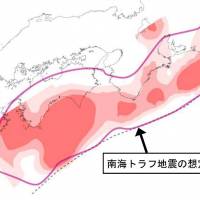Locations known as slip-deficit regions, which could trigger powerful earthquakes, are accumulating underground in the Pacific Ocean off central Japan where the Nankai Trough quake is forecast, research by a team of Japan Coast Guard officers published Tuesday in the British science journal Nature showed.
Slip-deficit regions are places where friction prevents tectonic plates from moving over each other. This causes energy to accumulate and eventually leads to a mega-earthquake.
The latest research discovered there is an accumulation of slip-deficit regions in areas off Shikoku and around the Kumano Sea south of Mie Prefecture, and in a region off Shizuoka Prefecture where the Tokai earthquake is predicted to hit.
It is the first time the slip-deficit regions have been located in detail.
"Our findings provide information for inferring mega-thrust earthquake scenarios and interpreting research on the Nankai Trough subduction zone," the research team wrote in the article.
It shows that off Shikoku, the area with the slip-deficit region was wider than when a series of Tonankai and Nankai mega-earthquakes struck during the 1940s. It was smaller in southern parts of the Hyuga-nada Sea off Miyazaki Prefecture because the boundary between the plates have slid gently, causing the slip-deficit region to disappear.
According to the Coast Guard, the government has already prepared disaster prevention measures reflecting the research, and there is no need to expand damage estimates.
It has been conducting research since 2006, compiling data by locating 15 undersea observation points along the Nankai Trough and measuring slight movements of the seafloor using survey ships equipped with GPS and echo-ranging devices.
The slip-deficit regions are mostly concentrated at the confluence of the Eurasian and the Philippine Sea plates. The observation points have moved up to 6 cm over the past decade, which shows that the slip-deficit regions are accumulating.




